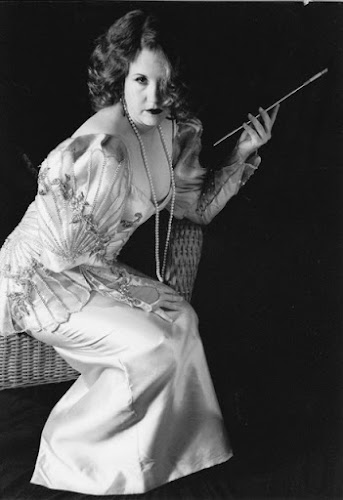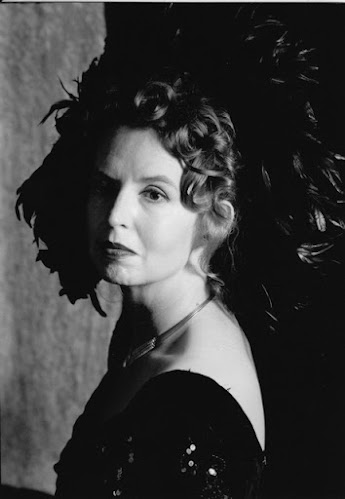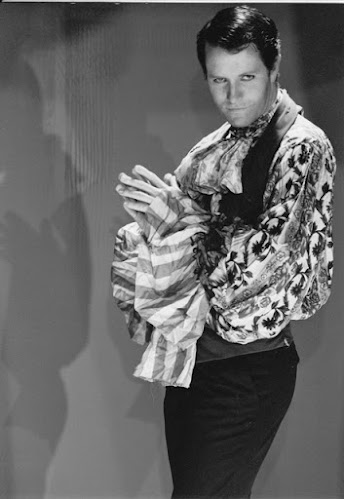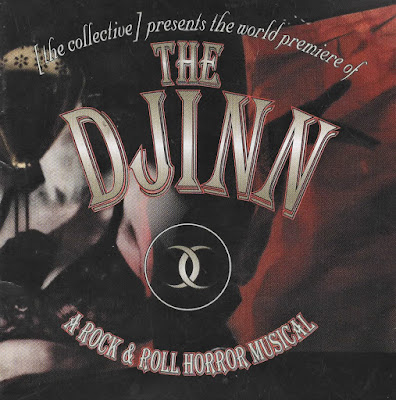In the show itself, the vaudevillians were shambling zombies, shadows of their former limelight-and-slapstick selves, but we decorated the lobby with photos of them in their prime, along with little fake bios. The fantastic portrait photos were taken by Kat Ward and the real-life actors were Dana Middleton, Elizabeth Romaine, Randy Schulman, Kevin Gregg, Delcie Adams, Dave Tushla, Jen Phinney, Jon Davis, and Kate McLaughlin. (The cast was rounded out by Rick Lee, Andrew Wenzlaff, and yours truly, but we didn't get to be among the ranks of the glorious dead):
Zelda Abernathy (1875-1909): At one time the toast of the Great White Way for her charming performances in American productions of Gilbert & Sullivan, she fell from grace after an unfortunate love affair with a minor Symbolist poet introduced her to the joys of opium. She spent the last decade of her career touring increasingly down-market Vaudeville houses, finally taking her own life in the wings of "Baxter's Varieties", a Burlesque in Cincinatti. Sadly, a telegram was delivered hours after her death offering her a major role in a Broadway revival of Lady Windermere's Fan.
Yvonne Bulstrode (1850 - 1921): For three years in the mid 1860s, she was the decorative half of "Valozzi & Yvonne", an all-purpose music, magic, and comedy act that won little acclaim. Wooed and won by a midwest Railroad Baron, she left the stage at 17 to become wife, mother of nine, and doyenne of Chicago society. In 1917, a widow for more than a decade, she took part in a charity revue - in which she was spotted by D W Griffith, who enticed her to Hollywood. She specialized for four years in 'sweet old lady' roles despite rumors of a spectacularly sexually-adventurous private life.
Xavier Carducci (1869-1902): Throughout the 1890s, Carducci was the most celebrated of the vaudevillian escape artists. His fame has been completely eclipsed by that of his slightly younger successor Harry Houdini (said to have been inspired in his choice of career by seeing Carducci perform in 1893) but matters may have been different if Carducci had not died in a tragic on-stage accident at the young age of 33. Carducci also had a pleasant baritone voice and apparently performed (unfortunately in blackface) as his own opening act on more than one occasion without the audience knowing it.
Walter Donnelly (1862-1910): Immensely popular with audiences of the 1880s and '90s, to whom he was known (and billed) as "The King of the Comic Song", Donnelly, an Alabamian, was privately known by colleagues as "The Bastard from Birmingham". He was reputed to have scouts on his payroll check out any other act with whom he was to perform and then pressure the theater to place him earlier on the bill - where he would deliberately employ catchphrases or business from the other act's routine. Paradoxically generous financially, he endowed several charities that cared for Vaudeville retirees.
Virginia Espinoza (1894-1923): Claiming to have studied with the Ballets Russes in Paris, her terpsichorean education actually took place in a rented room above her father's saloon on the Barbary Coast. But, though she danced only in Vaudeville, her performances were said to be the equal of anything seen on the classical stage. In a startling career-change at 23, she moved to Hollywood and became the comic and romantic foil of Benny Dyson, one of many second-string Chaplin imitators, in a popular series of two-reelers. Her death during a party on a private yacht moored off Santa Monica is still shrouded in mystery.
Uther Fitzgerald (1878-1912): Once a serious monologist, specializing in stentorian declamations of speeches from Shakespeare, Fitzgerald found his true calling one night in 1906 when performing in front of a particularly rowdy and unreceptive crowd in Kansas. Stopping midway through one of Richard II's duller soliloquies, he challenged any man in the room to come up and silence him. The standing ovation he received after his on-stage thrashing of the local ruffian who was foolish enough to take him up on it led to 'The Challenge' becoming a permanent part of his act. After years of fame as 'The Shakespearean Pugilist', he was shot in the back while leaving a Baltimore theater, his assassin a local tough whom he had bested earlier that evening.
Tamara "Tommy" Goldstein (1883-1937): A huge favorite on the big-city circuit, Goldstein's cross-dressing act was never popular in the hinterlands - apparently because her stage persona Tommy (an outrageously bawdy young-man-on-the-make) - was so utterly convincing that provincial audiences never got the joke. The more sophisticated urban crowds loved (and were doubtless titillated by) "his" innuendo-fueled jokes and flirtatious delivery of love songs to the female members of the audience. Keeping her figure slim and her hair short, Goldstein managed to maintain Tommy's youthful onstage appearance into her early 50s. Returning to America from a succesful European tour in 1937, she was among the passengers killed in the crash of the airship Hindenburg.
Stefan Holderlin (1863-1931): Originally a third-rate song-and-dance man, Holderlin dropped out of sight in the mid '90s and returned to the boards in 1902 having reinvented himself as 'Holderlin the Uncanny', specializing in magic and mesmerism. Claiming (falsely) to be the great-grandson of the German Romantic poet Friedrich Holderlin, he also attested to having learned his preternatural skills in a secret Buddhist monastery in the Himalayas, something which was never disproved but is considered unlikely. He enjoyed nearly two decades of success and then, retiring from the stage, spent the last ten years of his life writing increasingly-esoteric books on the occult, the most popular being Splinters of the Infinite, still in print today
Ramona Inamorata (1881-1919): Inamorata had one of the strangest - in fact, possibly unique - acts in the history of Vaudeville. A professional Stigmatist, she would appear on stage heralded by sacred organ music and clad in Nun's robes and bleed spontaneously from her palms and feet in evocation of Christ's suffering on the cross. By all accounts this ridiculous - indeed sacrilegious - performance was usually greeted in pious and approving silence in even the most traditionally rowdy houses and local priests would often appear at her shows to lend support. Though attacked in print by many serious theologians, nobody ever managed to prove her act a fake. At the age of 38, having amassed quite a fortune, she left a note in her upstate New York home leaving all her money to charity and ending with the simple phrase, "Our Lord has told me to meet him in the hills". Witnesses saw her walking into a heavily wooded area late that afternoon. She has never been seen since.
This was the cover of the program (cannily sized and shaped as a CD booklet to encourage the purchase of the CDs of the score, which were on sale in the lobby):
And this was the back cover, complete with a little informational note of welcome to each lucky audience member:
(Artwork for the poster and the program was by my pal and Invisible Cinema bandmate Steve Montiglio.)













No comments:
Post a Comment